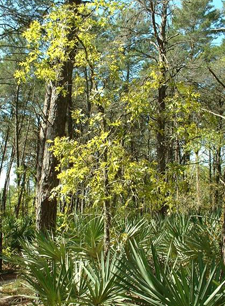
The Osceola wild turkey is no different than the other subspecies of wild turkeys in that they must have escape cover, a place to roost, a place to raise young ‘uns, a place to eat in the winter, summer, and fall, and a place to nest. What is different about the Osceola than the other subspecies is the type of habitat that satisfies those requirements. The goal of this page is to describe some of those areas so that you can easily spot them on a map or with a quick drive through of your hunting area. Since this is a hunting/educational site, we are going to focus on the roosting and nesting habitats.
Osceola wild turkeys prefer a roosting site that hides the birds from predators. The Osceola looks for large trees with big canopies to do just that and to offer some protection from those often violent Florida rain and thunderstorms. Osceola’s prefer to roost over, or very near, water in a Cypress or Pine tree, but that may not be the case depending on pressure from humans and availability. Osceola’s also prefer their roost sites to be near an opening to fly into and out of. So, big timber that is adjacent to pastureland, grassland, or fresh clearcut land is very good roosting habitat.
After flydown, the Osceola will spend a great deal of time feeding, displaying, and breeding in the open area before the temperature gets too hot. As the temperature climbs into the day, the Osceola will retreat to shady hardwood bottoms and palmetto hammocks to escape the heat and sun. As the temperature starts to cool down and the shadows get longer, the Osceola turkey will move back into the open areas to reassemble and feed before flying up to roost for the night. Keep these movement patterns in mind when you are on your Osceola hunting trip.
At some point during the hunting season, the hens will begin building nests to lay eggs in. Preferred habitat for a nesting hen is dense ground cover vegetation that is about 3 feet high. This will provide cover from all directions for an incubating hen. Nests can typically be found under fallen trees or tree tops, edges of hayfields, pastures, and old fallow fields, and even in wind-rowed cutover. Late season Osceola hunters should hunt close to nesting habitat as gobblers will move through those areas looking for hens who may be willing to participate in a little extra curricular activity.
Good escape cover consists of fairly dense vegetation where a turkey can disappear from predators in. Nesting and escape cover are usually pretty easy to find in Osceola country because of the nature of the plant species that grow there.
In the Fall and Winter, Osceola turkeys generally will stay in the open forested areas and very near the edges of the fields and forested areas. Turkeys are feeding on acorns at that time of year, and they are usually plentiful in the hardwood bottoms.
Summer and brood rearing habitats are comprised of grassy, open areas with lots of insects and escape cover that is nearby. Good escape cover for poults will allow the poults to move through easily and allow the hen to see over the top of it.